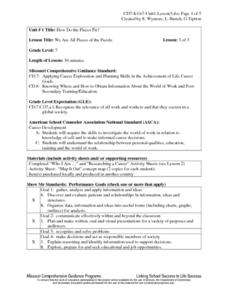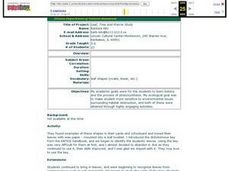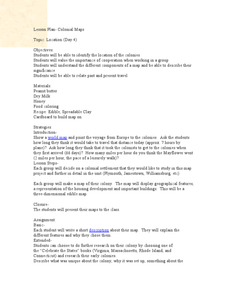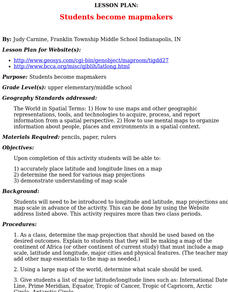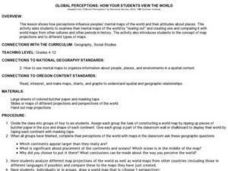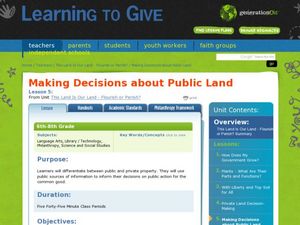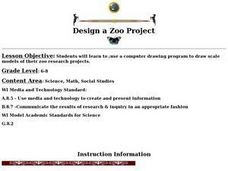Curated OER
Travelogs
Students make travelog journals to send to acquaintances in other states in order to receive mail in return. They make scrapbooks with the return mail they receive.
Curated OER
Ring of Fire
Students locate some of the 1,500 active volcanoes on a world map. Then by comparing their maps with a map of the world's tectonic plates, they discover that volcanoes occur because of the dynamic nature of the Earth's lithosphere.
Curated OER
Italy: The Landscape
Students work in small groups to create a topographic map of Italy. They must include labeled line drawings of bordering countries and bodies of water. Students use salt and flour clay to make Italy three dimensional, showing the many...
Curated OER
Interdependence in a Global Community
Students locate the geographic origin of a variety of products used in our society. They find countries in an atlas or on a wall map. They define the term imports and emphasize the theme of MOVEMENT and use it to explain interdependence.
Curated OER
The Sweet Connection
Students use maps to find what crops are dominant in areas where honey bees are raised and discuss possible correlations. They mark the top ten honey- producing states on a US map.
Curated OER
Palms and Literature
Students read and analyze the Civil War novel, 'Charley Skedaddle.' They define key vocabulary terms, develop a story map, create a concept web for a character, and take vocabulary tests.
Curated OER
We Are All Pieces of the Puzzle
Seventh graders are shown a small puzzle. They are explained that without all the pieces, a puzzle is not complete. Students are explained that the same principle applies to the world of work. They are also explained that each person who...
Curated OER
ExplorA-Pond: 1st Grade Shapes
Young explorers review the basic shapes (circle, triangle, square, rectangle) and practice putting them together to make new shapes. Given an outline of a pond, they recreate it by combining other shapes.
Curated OER
Aerial Photography
Eleventh graders compare the artistic values of Terry Evans' photography with LandSAT images and other images made for purely scientific, government and commercial purposes. They consider the artistic choices made in aerial photography.
Curated OER
Identifying Issues facing Africa
Pupils identify 5 issues facing Africa as a class The work in teams to create a joint project, conduct independent research into Africa, and present these ideas in a persuasive argument. The work in their groups in class to plan their...
Curated OER
My Home of North Dakota
Discuss the people, history and geography of North Dakota using this resource. Learners use a variety of sources to do research on North Dakota and present their findings in a PowerPoint presentation. They answer questions involving...
Curated OER
Harvesting Water from Fog
Students analyze the water issues of Cape Verde in the Peace Corp lesson. In this water resources lesson, students analyze the concept of water being harvested from fog. Students explore the Peace Corps project site by watching...
Curated OER
Hill of Fire
Students examine Paricutin eruptions. In this science lesson, students locate Paricutin on a map and take a virtual tour of volcanoes around the world. Students email questions to a geologist and create a news report on the original...
Curated OER
Leaf, Tree and Prairie Study
Pupils are introduced to the topic of Botany and the process of photosynthesis. Using various habitats, they research the amount of destruction it is facing and how to solve the problem. They make a leaf booklet with leaves they find at...
Curated OER
When I Was Young In Appalachia
Young scholars comapre and contrast the lifestyles of the people of the Applachian region with their own community through in-class discussions, creative projects, hands-on activities, food preservation, homemade remedies, home...
Curated OER
Colonial Maps
Students discover the history of America by identifying the traditional colonies. In this U.S. history lesson, students examine a world map and identify where the voyagers left from Europe to arrive at the United States. ...
Curated OER
Students Become Mapmakers
Learners practice making a map of a continent and correctly plotting five cities on that map. They place latitude and longitude lines on a map, determine the need for various map projections and explain why map scales are necessary.
Curated OER
Global Perceptions: How Your Students View the World
Students examine their own perceptions and attitudes about places around the world. Using their mental maps, they compare and contrast it with a world map from different periods in history. They review the various types of map...
Curated OER
Fractile vs. Equal
Students compare and contrast methods of categorizing data. In this data collection lesson plan, students complete worksheet activities that require them to note the differences between equal and fractile intervals. Students also discuss...
Curated OER
Family Tree
Students create a family tree in this culminating activity to their family unit. In this family tree activity, students extend their learning about the family unit by working in small groups to develop a three generation family tree....
Curated OER
How Do I Get There From Here?
Sixth graders use a school map to create a charted course and a corresponding written description of the directions for travel from class to class, beginning with an arrival location in the morning and ending with a departure location in...
Curated OER
U.S. Puzzle Map Bulletin Board
Students create cutouts of each state. They research different states noting their similarities and differences. They describe each state's location in relation to the state's surrounding them.
Curated OER
Making Decisions About Public Land
Students write a proposal. For this public land lesson, students discuss the difference between private and public property and brainstorm what problems might occur if a citizen changed public property. Students work in groups to write a...
Curated OER
Design a Zoo Project
Students research animals to become experts on them. They design a zoo to fit their animal's climate and region. They create a computer drawing of their zoo at the end of the lesson.






